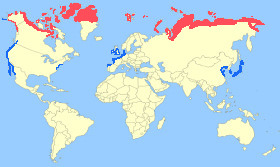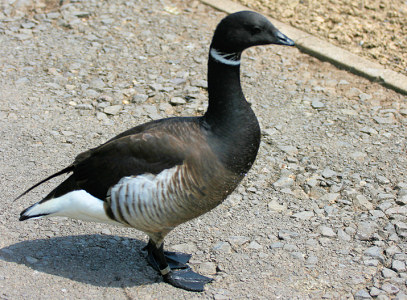Appearance: - The small Brent Goose has a black head, neck and upper-breast, with white markings or collar around the neck, short black beak, upperparts are greyish-brown, tail-coverts and sides of rump are white, underparts are pale brownish-grey or whitish, flight feathers and short tail are black, and the legs and feet are black. Both sexes are alike with the female being smaller.
Size: - Typical Adult is about 60cm (23in).
Food: - Eelgrass, seaweed, sea lettuce, also grazes on grasses, and cereals.
Habitat/Range: - Low-lying wet coastal tundra, estuaries, and agricultural land in north greenland, arctic Russia and Siberia, and arctic Canada. Wintering in coastal USA, Mexico, UK, Europe, Japan, South Korea, and China.

 Breeding Habitat/Resident,
Breeding Habitat/Resident,  Migration or Winter Area.
Migration or Winter Area.Breeding Season: - June.
Eggs: - 3 to 5 (creamy-white colour).
Notes: - The Brent Goose or Brant Goose belongs to the Branta genus and has three sub-species: Dark-bellied Brent, Light-bellied (Atlantic) Brent, and the Black Brent (Pacific). Dark-bellied Brents breed in arctic Russia, Light-bellied Brents in Greenland, and Black Brent in Arctic Canada. These birds breed further north than any other goose.
Conservation status (IUCN 3.1):
Least Concern.
Classification: - Family: Anatidae,
Subfamily: Anserinae, Genus: Branta.























